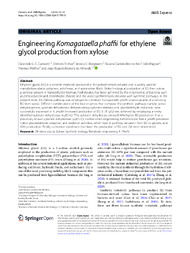Engineering Komagataella phaffii for ethylene glycol production from xylose.
Engineering Komagataella phaffii for ethylene glycol production from xylose.
Autoria: CARNEIRO, C. V. G. C.; TRICHEZ, D; BERGMANN, J. C.; REIS, V. C. B.; WAGNER, N.; WALTHER, T.; ALMEIDA, J. R. M. de
Resumo: Ethylene glycol (EG) is a versatile molecule produced in the petrochemical industry and is widely used to manufacture plastic polymers, anti-freeze, and automotive fluids. Biotechnological production of EG from xylose, a pentose present in lignocellulose biomass hydrolysates, has been achieved by the engineering of bacteria, such as Escherichia coli and Enterobacter cloacae, and the yeast Saccharomyces cerevisiae with synthetic pathways. In the present work, the Dahms pathway was employed to construct Komagataella phaffii strains capable of producing EG from xylose. Different combinations of the four enzymes that compose the synthetic pathway, namely, xylose dehydrogenase, xylonate dehydratase, dehydro-deoxy-xylonate aldolase, and glycolaldehyde reductase, were successfully expressed in K. phaffii. Increased production of EG (1.31 g/L) was achieved by employing a newly identified xylonate dehydratase (xylD-HL). This xylonate dehydratase allowed 30% higher EG production than a previously known xylonate dehydratase (xylD-CC). Further strain engineering demonstrated that K. phaffii possesses native glycolaldehyde reduction and oxidation activities, which lead to pathway deviation from EG to glycolic acid (GA) production. Finally, cultivation conditions that favor the production of EG over GA were determined.
Ano de publicação: 2024
Tipo de publicação: Artigo de periódico
Unidade: Embrapa Agroenergia
Palavras-chave: Ethylene glycol, K Phaffii, Metabolic engineering, Synthetic biology, Xylose
Observações
1 - Por padrão são exibidas publicações dos últimos 20 anos. Para encontrar publicações mais antigas, configure o filtro ano de publicação, colocando o ano a partir do qual você deseja encontrar publicações. O filtro está na coluna da esquerda na busca acima.
2 - Para ler algumas publicações da Embrapa (apenas as que estão em formato ePub), é necessário ter, no celular ou computador, um desses softwares gratuitos. Sistemas Android: Google Play Livros; IOS: iBooks; Windows e Linux: software Calibre.
Acesse outras publicações
Acesse a Base de Dados da Pesquisa Agropecuária (BDPA) para consultar o acervo completo das bibliotecas da Embrapa.

